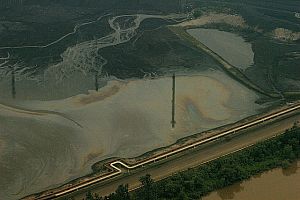Alberta’s oilsands industry faces an exponential problem: mounting volumes of tailings waste that is both environmentally damaging and difficult to clean up. Since the inception of the mining industry in northeastern Alberta, companies have grappled with how to treat, store and ultimately reclaim the toxic by-product of their extractive business. According to Alberta Environment and Sustainable Resource Development, 976 billion liters of toxic liquid covering 220 square kilometres is contained in dams, dykes, ponds and beaches in the oilsands region.
Alberta unveils a new policy framework for tailings management
Last Friday, the Government of Alberta released a framework meant to steer industry in a more productive direction on the issue of long-term tailings management. The Tailings Management Framework for the Mineable Athabasca Oil Sands (the framework) represents the first policy in Alberta to set targets for both legacy tailings — those produced between 1967 and 2015 — and new tailings that will be created as mining projects continue their operations.
Prior to releasing this framework, the oilsands mining industry was governed by Directive 074: Tailings Performance Criteria and Requirements for Oil Sands Mining Schemes. Directive 074 required oilsands companies to capture and dry a minimum proportion of their new tailings waste and to continue to reduce the rate of liquid tailings stored on the landscape each year. By 2013, operators were meant to capture and dry 50 per cent of their new tailings production. Unfortunately, industry has — year-over-year — failed to comply with these rules. As a result, tailings waste continues to accumulate on the landscape without consequence.
New framework has loopholes
The new tailings framework has several weaknesses that must be addressed for the policy to be effective.
First, Alberta must show — through appropriate price signals — that it expects industry to prioritize resolving its economic and environmental liabilities. To do this, Alberta should ensure it’s more expensive to break the new tailings rules than it is to comply with them. Experience has shown that oilsands companies will choose the lowest-cost form of compliance whether it’s paying a fee or adopting a new form of technology.
 Despite stating companies are required to post additional financial security to the Mine Financial Security Program (MFSP), Alberta has yet to determine the rate and frequency at which companies pay in to the program. If the MFSP penalty is set too low, Albertans will not be protected from the financial risk of reclamation and companies will not have an appropriate monetary incentive to comply with the tailings framework. In conjunction with the MFSP penalty, we support the implementation of a permanent financial penalty – the value of which could be used to shield taxpayers from administrative fees incurred if Alberta outsources reclamation activities.
Despite stating companies are required to post additional financial security to the Mine Financial Security Program (MFSP), Alberta has yet to determine the rate and frequency at which companies pay in to the program. If the MFSP penalty is set too low, Albertans will not be protected from the financial risk of reclamation and companies will not have an appropriate monetary incentive to comply with the tailings framework. In conjunction with the MFSP penalty, we support the implementation of a permanent financial penalty – the value of which could be used to shield taxpayers from administrative fees incurred if Alberta outsources reclamation activities.
Alberta must be precautionary in its collection of penalties given the slow progress towards tailings reclamation to date. The tailings framework is unlikely to achieve its intended impact unless the financial penalty for poor performance is more expensive than the average cost of implementing best available tailings technologies. Resolving this question is left to the Alberta Energy Regulator — the same organization that chose not to enforce Directive 074 despite industry’s consistently poor performance.
In addition to establishing the financial value of the MFSP penalty, we suggest Alberta modify the framework to ensure enforcement actions are introduced earlier over the course of a project’s life. As currently articulated, the framework is too flexible to non-compliance from operators. It tolerates up to a 20 per cent deviation from forecasted tailings production on an annual basis and up to 40 per cent from forecasted end-of-mine-life volume. Modifying the framework to tolerate less deviation from intended tailings trajectories would increase its usefulness as a tool to protect Albertans from environmental and economic liabilities. We recommend the trigger and limit values be re-assessed and minimized to ensure the framework meets its social, economic and environmental objectives under the Lower Athabasca Regional Plan.
Time to turn the page on tailings mismanagement
For too long tailings management has been a sore spot for industry and government. Progress towards reclamation has been slow and disappointing. Despite several decades’ worth of research and development, there remains considerable uncertainty as to whether tailings can ever be reclaimed to a level that sustains productive, useful ecosystems. Moreover, industry associations, such as Canada’s Oil Sands Innovation Alliance, have yet to produce evidence showing industry can comply with existing regulatory requirements. Because of this, and because of industry’s low compliance with government mandated clean-up targets, tailings have become the target of local and international criticism.
We’re hopeful — with the release of this framework — Alberta is taking a step towards correcting its lackluster track record. If the framework and its enabling policies are reformed to protect the public from undue liability — and enforced in a rigorous and predictable manner — it could result in meaningful progress on this important issue. We look forward to working with Alberta to iron out critical policy gaps and to ensure the tailings management framework reduces the volume of toxic tailings stored on our landscape.










